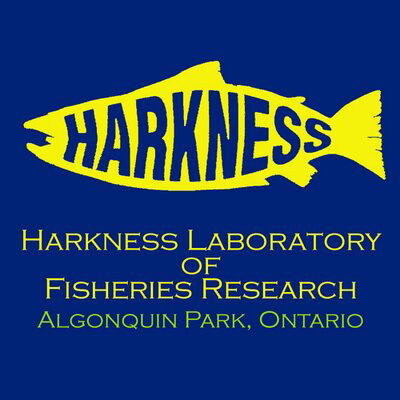Events Calendar
Current Weather
May 23, 2017
Lake of Two Rivers Fish Tracking Project
 Algonquin Park contains over 180 lakes with native Lake Trout populations. To effectively manage these populations and ensure their long term sustainability, effective monitoring methods must be developed. Lake of Two Rivers has been selected as a study lake in which to monitor Lake Trout and Smallmouth Bass movements for the next two years (2017-2019).
Algonquin Park contains over 180 lakes with native Lake Trout populations. To effectively manage these populations and ensure their long term sustainability, effective monitoring methods must be developed. Lake of Two Rivers has been selected as a study lake in which to monitor Lake Trout and Smallmouth Bass movements for the next two years (2017-2019).
The Tracking Technology
Harkness Laboratory of Fisheries Research will be tracking 20 Lake Trout and 10 Smallmouth Bass in Lake of Two Rivers. The tracking system consists of 49 acoustic receivers deployed in the lake. There are also six reference sites that are stationary fish tags, used to determine the accuracy on the tracking system.
![]()
Image: Harkness Laboratory of Fisheries Research staff installing an acoustic tag in a Lake Trout.
| Image: The tags that have been surgically implanted into the fish’s body cavity are about the size of a AAA battery. |
Tagged fish can be identified by a red external tag located by the dorsal fin and visible sutures for the first 2-3 months after the surgery. Every 5-10 minutes the transmitters send out the unique ID and depth of the fish and the network receives these transmissions. Using triangulation methods similar to those used by GPS a very accurate 3D position of each fish can be calculated. Over the course of the two years we will collect upwards of 100,000 3D positions for each of the tagged fish.
The Importance of Understanding Fish Movement
![]()
Map: Each point in the lake represents one of the 49 acoustic receivers or one of the six reference sites. All of the receivers and reference sites are suspended with a float 1.5 metres under the surface of the water.
| Image: Acoustic receiver used in Lake of Two Rivers. |
Understanding how fish move is important for a variety of reasons. One of the primary goals of this project is to improve a new netting protocol in development by Harkness Laboratory of Fisheries Research. The new protocol uses netting gear set for a short duration (one hour), which ensures little to no mortality for sensitive trout populations. This type of work has already been completed for Brook Trout using data collected on Welcome, Scott and Stringer Lakes.
When using this new protocol to calculate population estimates, there are a number of considerations taken into account, one of these is the odds a fish will encounter the netting gear. The netting gear captures fish in the bottom two meters of the water column, although it is known that fish are not always within this area. To account for this, we determine how much time fish spend within two meters of the bottom relative to the rest of the water column. This is calculated for different depth ranges as the chances a fish will encounter the netting gear varies by depth. If we look at the 0-3m depth range in the diagram below, we can see there are four fish tracking locations, one that would not be caught and three that would be caught in the netting gear. From this data we would estimate that in the depth range from 0-3m, there is a 75% chance that a fish would encounter the netting gear. Compared to the 6-12m depth range where there is only a 20% chance that a fish would encounter the netting gear. This is simply an example to explain the principle; the actual data used for these calculations will consist of 100,000s of tracking locations for each species.
![]()
Image: Installing an acoustic tag in a Smallmouth Bass from Lake of Two Rivers.
Additionally, the project will provide information on spawning locations and timing, home range and seasonal variations in activity. All of this data is critical for developing fisheries management plans and setting fishing regulations.
![]()
Diagram: A cross-section of a lake, showing tracking locations at different depth ranges. The brown line represents the lake bottom, and the red line represents the top of the netting gear. The green points are tracking locations within the depth range of the netting gear and the orange points show tracking locations above the netting gear. The cross-section is broken into three depth ranges that correspond to the netting protocol.
What You Can Do?
![]()
Image: Measuring a Smallmouth Bass from Lake of Two Rivers in Algonquin Park.
If you should happen to catch a fish with a telemetry tag we ask that you release it, allowing us to continue collecting data from it. If, for reason of injury or otherwise, the fish cannot be released, we would appreciate your returning the internal tag to us at Harkness Lab. Keeping in mind the fishing regulations prohibit the harvest of Lake Trout from Lake of Two Rivers with a total length between 40 - 55 centimetres. We apologize for the inconvenience but the data collected in this study is extremely important to manage fisheries across Algonquin Park and Ontario.
Related Information
- Harkness Laboratory of Fisheries Research
- Fishing in Algonquin Park
- Fishes of Algonquin Provincial Park
- Raven Talks About Fish and Lakes
- Fishing in Algonquin Provincial Park
Reserve your developed or backcountry campsite for your next visit.
Share your passion for Algonquin Park by becoming a member or donor.
Special regulations for Algonquin's special fishery.









